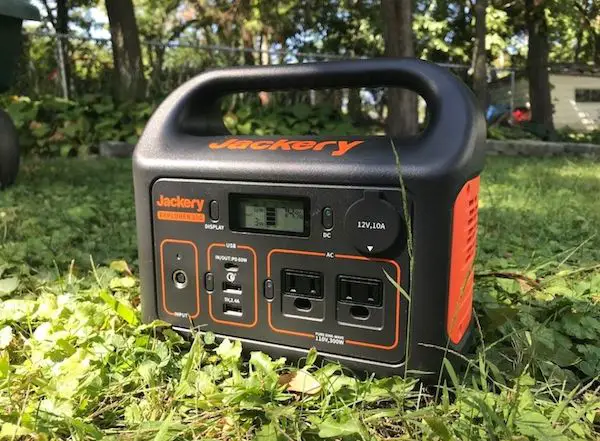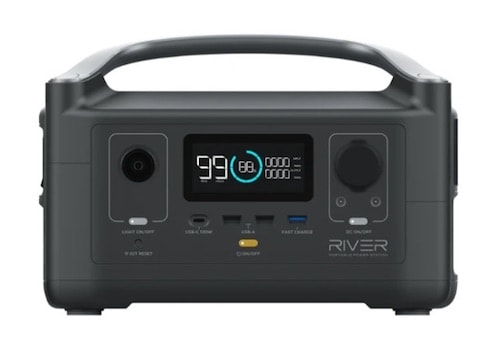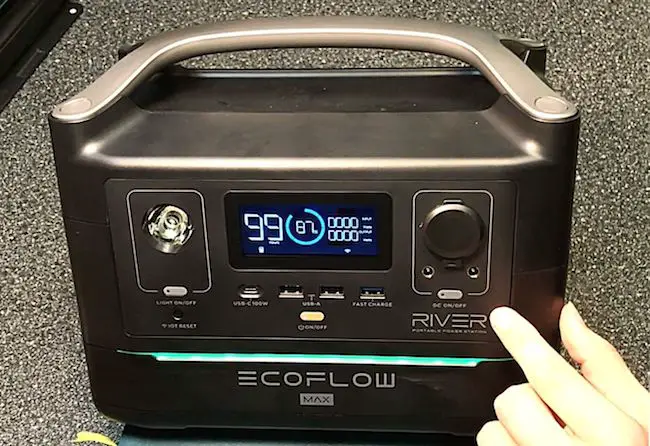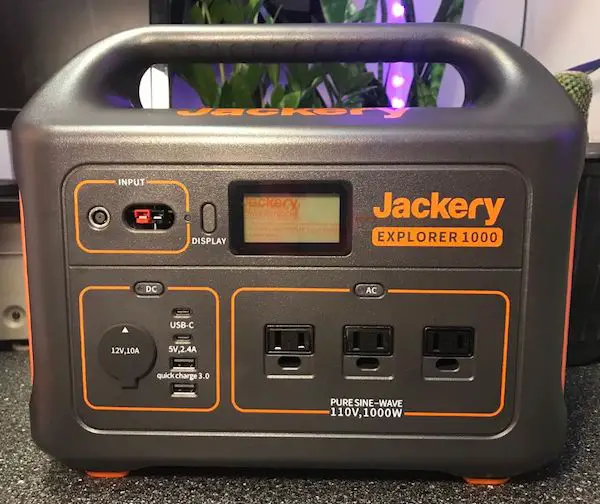In this comparison of portable power stations, I took similar models from EcoFlow and Jackery and compared them directly.
I then added up their pros and cons and picked a winner for each comparison.
Overall, EcoFlow is better than Jackery because their solar generators have better inverter performance, more output ports, and faster recharging times when comparing similar models. Although Jackery has a more diverse line of solar generators, their core models are inferior to EcoFlow’s.
Today we’ll be comparing the following solar generators (click a comparison to jump to that section):
- EcoFlow River vs. Jackery Explorer 300 vs. Jackery Explorer 240
- EcoFlow River Max vs. Jackery Explorer 500
- EcoFlow Delta 1300 vs. Jackery Explorer 1000
- EcoFlow Delta 1300 vs. Jackery Explorer 1500
If you’d also like to see how Jackery’s portable power stations compare to Goal Zero’s, I recommend also checking out my in-depth comparison post found here: Goal Zero vs. Jackery – Battle of the Brands (Cost/Specs/Analysis).
EcoFlow River vs. Jackery Explorer 300 vs. Jackery Explorer 240
The EcoFlow River is the best solar generator compared to Jackery’s Explorer 300 and 240 because it has the highest AC inverter rating (600W continuous, 1,200W surge), the most output ports (10), and the highest solar input at 200W.
| Ranking | Highlights |
|---|---|
| 1. Best Overall EcoFlow River | – Highest solar input – Highest inverter rating – Most output ports |
| 2. Best Value Jackery Explorer 240 | – $100 cheaper than the other options |
| 3. Best Power-to-Weight Jackery Explorer 300 | – 7.1 lbs is lightest compared to similar-sized power stations |
Below, I’ve compared the stats and laid them out so you can get a good idea of the similarities and differences of each power station.
| EcoFlow River |
|---|
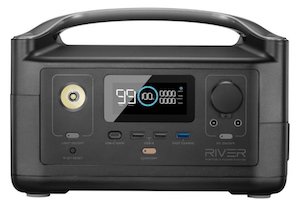 |
| Output Ports |
| 3x 120V AC: 600W (1,200W peak) 1x DC car port: 13.6V, 10A 2x DC5521: 13.6V, 3A max each 1x USB-C: 100W max 1x USB-A Fast Charge: 28W max 2x USB-A: 12W max each |
| Charge Times |
| AC: 1.6 hours Solar (at max input of 200W): 1.6-3 hours Car: 3 hours |
| General Info |
| Battery Capacity: 288Wh Dimensions: 11.3 x 7.7 x 7.3 in Weight: 11 lbs Battery Cycle Life: 500 cycles to 80% capacity Warranty: 24 months |
| EcoFlow River Review |
| Jackery Explorer 300 |
|---|
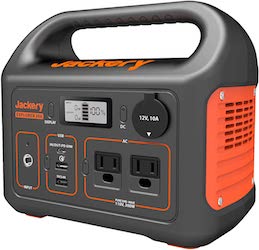 |
| Output Ports |
| 2x 110V AC: 300W (500W peak) 1x DC car port: 12V, 10A 1x USB-C PD: 60W max 1x USB-A QC3.0: 18W max 1x USB-A: 12W max |
| Charge Times |
| AC: 4.5 hours Solar (at max input of 90W): 5 hours Car: 5 hours USB-C PD: 5.5 hours |
| General Info |
| Battery Capacity: 293Wh Dimensions: 9.1 x 5.2 x 7.8 in Weight: 7.1 lbs Battery Cycle Life: 500 cycles to 80% capacity Warranty: 24 months |
| Jackery Explorer 300 Review |
| Jackery Explorer 240 |
|---|
 |
| Output Ports |
| 1x 110V AC: 200W (400W peak) 1x DC car port: 12V, 10A 2x USB-A: 12W max |
| Charge Times |
| AC: 7 hours Solar (at max input of 65W): 7 hours Car: 6.5 hours |
| General Info |
| Battery Capacity: 240Wh Dimensions: 5.19 x 9.05 x 7.67 in Weight: 6.6 lbs Battery Cycle Life: 500 cycles to 80% capacity Warranty: 24 months |
| Jackery Explorer 240 Review |
Overview of the Jackery Explorer 240 & 300
The Jackery 240 and 300 are very simple to use systems that are also portable. The Jackery 240 has been a staple product for Jackery for years, whereas the Jackery 300 is an updated version of the 240.
Jackery Explorer 240
The Jackery 240 has been one of Jackery’s best-selling products because it is reliable and inexpensive.
Although the 240 is not updated with newer USB-C ports and lacks in its overall quantity of port options, it costs one-third less than the Explorer 300 model.
Still to this day, the Explorer 240 is one of the lightest solar generators for its battery capacity, weighing only 6.6 pounds.
Jackery Explorer 300
With updated USB ports, an additional AC port, and a port cover for its car charger port, the Jackery 300 can power more devices at once than the 240 model.
Its entire construction is only half a pound heavier than the Explorer 240, yeti its 293Wh battery is 53Wh greater than the 240 version.
With a USB-C PD port with a 60W maximum output and input, you can charge laptops and other USB-C devices quickly. You can also charge the entire solar generator in 5.5 hours just using the USB-C PD port to charge it up.
Jackery Explorer 240 & 300: What Do They Come With?
- Explorer 240 or Explorer 300 power station
- AC adapter
- Car charger cable
- User manual
- 2-year warranty
Overview of the EcoFlow River
The EcoFlow River is the successor to the River 370 model, which came out to the public a few years prior to the newer generator.
What makes this system special is its versatility, power, and recharging capabilities.
You can add a second battery to the River to double its battery size, making it into the River Max power station (which I’ll be covering next).
Its inverter strength is off the charts by any solar generator in its class. It can run its AC ports at 600W continuous, which is double that of the Explorer 300.
Not only that, but you can utilize EcoFlow’s X-Boost feature to power larger, more power-intensive appliances like a microwave. So, in reality, it can power appliances of up to 1,200W.
This in a truly amazing feature, as 1,200 of continuous power is quadruple that of the Explorer 300 and even other larger solar generators.
EcoFlow River: What Does It Come With?
- River power station
- 1.5M AC charging cable
- 1.5M car charging cable
- 1.5M MC4 to XT60 solar charging cable
- User manual
- 2-year warranty
Pros & Cons of the Explorer 300, Explorer 240, and River
| Model | Jackery Explorer 300 | Jackery Explorer 240 | EcoFlow River |
|---|---|---|---|
| Pros | – Updated ports – Lightweight – 4 charging options | – Lightweight – Inexpensive – Over 7k Amazon ratings (4.8/5 avg.) | – High output and input – 10 output ports |
| Cons | – Doesn’t stand out compared to similar-sized models | – Few port options – Only has USB-A | – Heavy (11 lbs) |
Jackery 240 – Pros & Cons
At about $200, the Explorer 240 is the least expensive solar generator out of the three mentioned in this section. The River and Explorer 300 are both $300, which makes the 240 the best option in terms of overall value.
However, the 240 lack in a few key areas. First off, it has the fewest number of total output ports with only four of them. The Explorer 300 has six total and the River has 10 total.
Secondly, the USB ports on the Jackery 240 are only standard USB-As. This means that it will charge your devices at the maximum rate of 12W.
This is not ideal because the USB-C ports and fast-charging USB-A ports in the Explorer 300 and River far-exceed 12W of output power.
Jackery 300 – Pros & Cons
Out of all of the smaller Jackery solar generators (Explorer 500 and smaller), the Explorer 300 is the only one that has a 60W USB-C PD port. It is also the only one that has a car port cover to prevent dust and debris from getting into it.
It is also the lightest solar generator that I know of within the range of 280-320Wh of battery capacity.
Another feature that’s not common in similar-sized solar generators is a 60W USB-C PD port. Usually, you will see these ports in larger systems, but not 300Wh generators.
However, this model costs the exact same amount of money as the EcoFlow River, and if I had to choose between the two, I would 100% buy the River.
EcoFlow River – Pros & Cons
The River by far has the most pros out the the three models compared in this section. It has:
- Double the solar input of the Explorer 300 and triple the input of the Explorer 240
- 10 output ports (with fast charge USB-A and 100W USB-C)
- Double the AC inverter power of the Explorer 300 and triple the power of the Explorer 240
That being said, it is 1.5 times heavier than the Explorer 300 model standing at 11 pounds.
Also, when it comes to its AC port output, it almost doesn’t make sense to have such a powerful inverter, as it will not run larger appliances for a long time.
It makes more sense to get the River Max with double the battery size so you can run things like a desktop computer for twice as long.
EcoFlow River vs. Explorer 300 vs. Explorer 240 – What Can They Power?
| Appliance | Jackery Explorer 300 | Jackery Explorer 240 | EcoFlow River |
| Laptop (80Wh) | 3.3 Charges | 2.7 Charges | 3.6 Charges* |
| LCD TV (150W) | 1.75 Hours | 1.4 Hours | 1.73 Hours |
| Tablet (30Wh) | 9.75 Charges | 7.2 Charges | 9.6 Charges |
| Smartphone (8Wh) | 36.6 Charges | 30 Charges | 36 Charges |
| CPAP Machine (40W)* | 7.3 Hours | 6 Hours | 7.2 Hours |
| Desktop Computer (200W) | 1.3 Hours | No* | 1.3 Hours |
| Microwave Oven (1100W) | No | No | 14 Minutes |
| Blender (250W) | 1 Hour | No | 1 Hour |
| Toaster (650W) | No | No | 24 Minutes |
| Portable Refrigerator (70W) | 3.75 Hours | 3 Hours | 3.7 Hours |
*3.6 Charges – Using 100W USB port – No power loss from inverter
*CPAP Machine (40W) – Using DC-to-DC converter
*No – Up to 200W continuous, but put it as “No” because too close to power limit
Which Is Better Overall – The Jackery Explorer 300, Explorer 240, or EcoFlow River?
The EcoFlow River is the best solar generator of the three because it has more output power, more input (recharging) power, and more ports than the other options. It is the heaviest of the three, but this is the only downside.
| Generator | Jackery 300 | Jackery 240 | EcoFlow River |
|---|---|---|---|
| Highest Battery Capacity | X | ||
| Most Port Options | X | ||
| Highest-Powered AC Ports | X | ||
| Highest Solar Input | X | ||
| Lightest Weight | X | ||
| Cheapest Cost | X |
You can check out the EcoFlow River here on Amazon. Make sure to apply any coupons on the listing if they’re still available.
The above link is an affiliate link, where I make a small commission on every sale.
For more information on the Explorer 240 and/or 300, click the links below for my individual product reviews:
- The Jackery 240 – Solar Charger for the Outdoors
- Jackery Explorer 300 Review (Comparison & Analysis)
EcoFlow River Max vs. Jackery Explorer 500
The EcoFlow River Max is better than the Jackery Explorer 500 because it has double the solar input (200W vs. 100W), nearly five times faster AC wall charging times (1.6 hrs vs. 7.5 hrs), and higher-powered USB ports (USB-A fast charge and USB-C).
| Solar Generator | Output Ports | Charge Times | General Info | Price |
|---|---|---|---|---|
EcoFlow River Max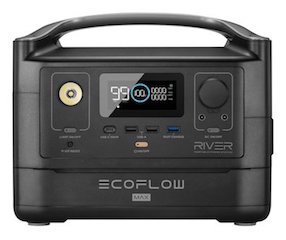 | 3x 120V AC: 600W continuous (1,200W peak) 1x DC car port: 13.6V, 10A 2x DC5521: 13.6V, 3A max each 1x USB-C: 100W max 1x USB-A Fast Charge: 28W max 2x Standard USB-A ports: 12W max each | AC: 1.6 hours Solar (at max input of 200W): 3-6 hours Car: 6.5 hours | Battery Capacity: 576Wh Dimensions: 12 x 8 x 10 in Weight: 17 lbs Battery Cycle Life: 500 cycles to 80% capacity Warranty: 24 months | Check Price on Shop Solar Kits |
Jackery Explorer 500 | 1x 110V AC: 500W continuous (1,000W peak) 1x DC car port: 12V, 10A 2x DC 6.5×1.4mm: 12V, 7A max each 3x Standard USB-A: 12W max each | AC: 7.5 hours Solar (at max input of 100W): 9.5 hours Car: 7.5 hours | Battery Capacity: 518Wh Dimensions: 11.8 x 7.6 x 9.5 in Weight: 13.32 lbs Battery Cycle Life: 500 cycles to 80% capacity Warranty: 24 months | Check Price on Amazon |
EcoFlow River Max – Overview & Application of Use
The River Max is basically a standard River power station with an additional battery. The added battery (which is detachable) brings twice the amount of battery life (576Wh) compared to the River (288Wh).
This makes the River Max extremely versatile. Since you can detach the additional battery (to make it into a standard River), you can use it for activities that may need more portability.
As seen from the table above, the River Max has all of the same ports as the standard River power station. This means a total of ten output ports – four of them being USB and three of them being AC ports.
EcoFlow River Max: What Does It Come With?
- River Max power station
- 1.5M AC charging cable
- 1.5M car charging cable
- 1.5M MC4 to XT60 solar charging cable
- USB-A 2.0 to Micro or Lightning cable
- USB-C to USB-C cable
- User manual
- 2-year warranty
Overview of the Jackery Explorer 500
The Explorer 500, like the Explorer 240, has been one of Jackery’s core solar generators for years. It is very similar to the 240 model, but has a few upgrades in addition to a bigger battery.
It hoists a 518Wh battery and its overall weight is just over 13 pounds.
Like most of Jackery’s power stations, the Explorer 500 is easy to use due to its simply laid out LCD screen and light weight.
Compared to the Explorer 240’s ports, the 500 model has:
- An additional standard USB-A port
- Two DC 6.5×1.4mm ports (the 240 has none)
- A higher solar input (100W vs 65W)
Jackery Explorer 500: What Does It Come With?
- Explorer 500 power station
- AC adapter
- Car charger cable
- User manual
- 2-year warranty
Pros & Cons of the River Max and Explorer 500
| Model | Jackery Explorer 500 | EcoFlow River Max |
|---|---|---|
| Pros | – Lightweight (13.3 lbs) – Easy to use | – 10 output ports – Detachable battery |
| Cons | – No USB-C ports – Only one AC port | – Heavy (17 lbs) |
Jackery Explorer 500 – Pros & Cons
As mentioned above, the Explorer 500 is just over 13 pounds – this makes it just slightly heavier than the Goal Zero Yeti 500X (12.9 lbs) and slightly lighter than the Bluetti AC50S (14 lbs).
The Explorer 500 has one special feature which is an LED flashlight on the left side of the power station. It also has an SOS function, which may be useful if you ever get lost at night in the wild.
Although the Jackery 500 has most basic functions of a solar generator, it does not have many different port options.
It can power DC devices, AC devices, and USB-A devices, but it has no USB-C ports and only one AC port. This is not ideal for current-day needs, as several devices use USB-C to charge up.
Having one AC port is not a big deal because you can attach a power strip to the AC port and use multiple AC-powered appliances at once if needed; however, there should be at least a second AC port available due to the power station’s larger size.
EcoFlow River Max – Pros & Cons
With several port options, a high solar input, and fast recharge times from the wall charger and from solar, the River Max is one of the best solar generators you can get in the 500-600Wh range.
The River Max has one of the best inverters in its size category, with 600W continuous and 1,200W surge power.
The only downside that stands out to me is its weight (17 lbs). This makes it about three pounds heavier than the average 500Wh solar generator.
Another downside is that the River Max is really just the River power station with an added battery. You get all of the same functions as you would from the standard River power station.
River Max vs. Explorer 500 – What Can They Power?
| Appliance | Jackery Explorer 500 | EcoFlow River Max |
| Laptop (80Wh) | 5.8 Charges | 7.2 Charges |
| LCD TV (150W) | 3 Hours | 3.5 Hours |
| Tablet (30Wh) | 15.5 Charges | 19.2 Charges |
| Smartphone (8Wh) | 65 Charges | 72 Charges |
| Desktop Computer (200W) | 2.3 Hours | 2.6 Hours |
| Microwave Oven (1100W) | No | 28 Minutes |
| Blender (250W) | 1.9 Hours | 2.1 Hours |
| Toaster (650W) | No | 48 Minutes |
| Portable Refrigerator (70W) | 6.7 Hours | 7.4 Hours |
Which Is Better Overall – The Explorer 500 or River Max?
| Generator | Jackery Explorer 500 | EcoFlow River Max |
|---|---|---|
| Higher Battery Capacity | X | |
| More Port Options | X | |
| Higher-Powered AC Ports | X | |
| Higher Solar Input | X | |
| Lighter Weight | X | |
| Cheaper Cost | X |
The EcoFlow River Max is the superior to the Explorer 500 because it has faster recharging, better port options, and it’s more versatile with its detachable battery.
The Explorer 500 cannot compete with any specification other than its weight.
I recommend the River Max hands down over the Jackery 500. You can find the EcoFlow River Max here on Amazon (be sure to apply any available coupons to your order – there’s currently a $70-off coupon). This is an affiliate link, where I make a small commission on every sale.
In case you want additional resources on the EcoFlow system, I own the River Max and made a YouTube review of it below.
EcoFlow Delta 1300 vs. Jackery Explorer 1000
The EcoFlow Delta is superior to the Jackery Explorer 1000 due to its larger battery (1,260 vs. 1,002Wh), more powerful AC output (1,800W vs. 1,000W continuous), and longer battery cycle life (800 vs. 500 cycles to 80% capacity).
The table below goes into the main specifications of each solar generator.
| Solar Generator | Output Ports | Charge Times | General Info | Price |
|---|---|---|---|---|
EcoFlow Delta 1300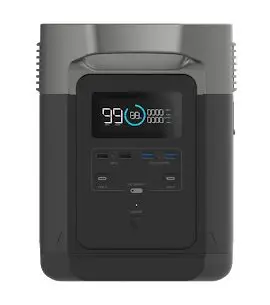 | 6x 120V AC: 1,800W continuous (3,300W peak) 1x DC car port: 13.6V, 8A 2x USB-C: 60W max each 2x USB-A Fast Charge: 28W max each 2x Standard USB-A: 12W max each | AC: 1.6 hours Solar (at max input of 400W): 3.5-7 hours Car: 10-12 hours | Battery Capacity: 1,260Wh Dimensions: 15.7 x 8.3 x 10.6 in Weight: 31 lbs Battery Cycle Life: 800 cycles to 80% capacity Warranty: 24 months | Check Price on Shop Solar Kits |
Jackery Explorer 1000 | 3x 110V AC: 1,000W continuous (2,000W peak) 1x DC car port: 12V, 10A 2x USB-C PD: 18W max 1x USB-A QC3.0: 18W max 1x Standard USB-A: 12W max | AC: 7 hours Solar (at max input of 163W): 8 hours Car: 14 hours | Battery Capacity: 1,002Wh Dimensions: 13.1 x 9.2 x 11.1 in Weight: 22 lbs Battery Cycle Life: 500 cycles to 80% capacity Warranty: 24 months | Check Price on Amazon |
Both of these solar generators have similar ports but the EcoFlow Delta simply has more of them.
The one major difference in ports comes to the AC ports, where the Delta has 1,800W of continuous power compared to the Explorer 1000’s 1,000W continuous.
So overall, not only is there more accessible AC power, but you can hook up way more devices at once.
EcoFlow Delta 1300 – Overview & Application of Use
This solar generator is fantastic for going on long trips or preparing for black-out emergencies.
The Delta 1300 can keep devices/gears running for days. Being the same size as a small microwave, it’s easier to manage in weight, plus, it has a dual handle feature to make the load easier to carry.
It also has more AC, USB-A, and USB-C ports than most other power stations in its class. While offering the highest max output, the Delta was capable of running electric devices and having a high battery capacity.
Devices such as laptops and CPAP machines could very well run all night long if needed.
The monitor interface is easy to understand and shows the input/output wattage left and how much power could be reserved.
What’s also useful in this solar generator is the output ports of six AC, four USB-A, and two USB-C. These ports make it easy to charge a variety of electric devices.
EcoFlow Delta 1300: What Does It Come With?
- Delta 1300 power station
- AC wall charger
- Solar charging cable (MC4 to XT60)
- Car charging cable
- User manual
- EFDELTA bag
- 2-year warranty
Overview of the Jackery Explorer 1000
The Explorer 1000 is also known for its tough exterior and highly portable design. It also includes a few output ports of 3 AC, 2 USB-A, and 2 USB-C, which provide an array of charging options.
One of the best specifications of this system is its weight. The Jackery 1000 only weighs 22 pounds, which is almost ten pounds lighter than the EcoFlow Delta and a whole 18 pounds lighter than the Yeti 1000 Lithium.
Since it’s the lightest solar generator of its 1,000Wh class, you can move it around much easier than other similar options. You can use it while car camping or move it around the house or cabin when you need power specifically in one room.
An often overlooked positive quality of the Jackery 1000 is its ease of use. It has a clear and concise LCD screen, which tells you the battery level, input wattage and output wattage.
This is all that most people need when using a generator like this.
Jackery Explorer 1000: What Does It Come With?
- Explorer 1000
- AC adapter
- SolarSaga parallel adapter cable
- Car charger cable
- User manual
- 2-year warranty
Pros & Cons of the Delta and Explorer 1000
The EcoFlow Delta stands out more from Jackery because of its max output, wide array of ports, and easy-to-use interface.
One downside is the size. The EcoFlow Delta 1300 is bigger and clunkier than the Jackery models, which might make it hard to go camping with.
But the EcoFlow Delta can power entire tiny houses, so the size difference might not mean that much if you want a generator that can power almost anything.
Unfortunately, the Jackery Explorer 1000 has a much lower max power output compared to the EcoFlow Delta 1300.
Therefore, it’s not the best power storage for electronic appliances that may need more wattage, such as a vacuum or AC. However, it can make up for this by having a high battery capacity to keep other lower watt devices running longer.
The Jackery 1000 costs between $900-$1,000 and the Delta 1300 costs between $1,100-$1,200.
The main question to ask yourself before deciding on which generator to get is: Do you want a generator that has a higher power output and can power things like microwaves or washing machines (Delta 1300), or do you just need one for devices that require lower power requirements (Jackery 1000)?
Delta 1300 vs. Explorer 1000 – What Can They Power?
The following table shows some examples of appliances and devices you can or can’t use along with their run/charging times:
| Appliance | Jackery Explorer 1000 | EcoFlow Delta 1300 |
| Laptop (80Wh) | 11.3 Charges | 14 Charges |
| LCD TV (150W) | 6 Hours | 7.5 Hours |
| Smartphone (8Wh) | 125 Charges | 157 Charges |
| Desktop Computer (200W) | 4.5 Hours | 5.7 Hours |
| Microwave Oven (1100W) | No | 1 Hour |
| Washing Machine (900W) | 1 Hour | 1.3 Hours |
| Blender (250W) | 3.6 Hours | 4.5 Hours |
| Toaster (650W) | 1.4 Hours | 1.8 Hours |
| Portable Refrigerator (70W) | 12.9 Hours | 16.2 Hours |
| Electric Saw (1400W) | No | 48 Minutes |
| Electric Grill (1600W) | No | 42 Minutes |
Both generators can power most devices but not power devices. With the battery capacity of EcoFlow being more efficient than Jackery, the devices mentioned can run for a long time.
What’s good to know is that both do have a strong surge capacity so higher-powered devices can be used, even if only for a short time limit.
Which Is Better Overall – The Explorer 1000 or Delta 1300?
The EcoFlow Delta is better than the Jackery Explorer 1000 in several ways. The table below will highlight what makes the Delta superior.
| Generator | Jackery Explorer 1000 | EcoFlow Delta 1300 |
|---|---|---|
| Higher Battery Capacity | X | |
| More Port Options | X | |
| Higher-Powered AC Ports | X | |
| Higher Solar Input | X | |
| Lighter Weight | X | |
| Cheaper Cost | X |
When comparing solar generators of this size, all options are going to be heavy. Although the Explorer 1000 is very light, its 22 pounds still makes it hard to carry for long distances.
The cost may be cheaper by $100-$200 than the EcoFlow Delta, but the Delta has better performance numbers in every significant category, including cycle life.
The Delta has 800 battery cycles to 80% capacity, whereas the Explorer 1000 has 500 to 80%. This means that the Delta will have 300 additional battery charge cycles before hitting around 80% of its original 1,260Wh capacity.
Basically, what this means is that the Delta will last longer than the Explorer 1000. This ultimately means that you’ll be getting much more value in terms of longevity from the Delta power station.
For more information or if you’d like the purchase the Delta, click here to view its Amazon listing (affiliate link).
If you’d like to compare pricing, check out the Jackery 1000 on Amazon here (affiliate link).
If you’d like additional specifications and additional analysis on the Delta 1300 or Explorer 1000, click the following links to similar articles:
- Jackery Explorer 1000 Portable Power Station – Review and Analysis
- Ecoflow Delta vs Bluetti EB240 – Which Is Best?
EcoFlow Delta 1300 vs. Jackery Explorer 1500
The EcoFlow Delta is better than the Jackery Explorer 1500 because it has the same continuous AC inverter rating (1,800W) and more output ports (13 vs. 7). Although the Explorer 1500 has a higher battery capacity (+228Wh) and solar input (+100W), the Delta 1300 costs about $300 less.
| Solar Generator | Output Ports | Charge Times | General Info | Price |
|---|---|---|---|---|
EcoFlow Delta 1300 | 6x 120V AC: 1,800W continuous (3,300W peak) 1x DC car port: 13.6V, 8A 2x USB-C: 60W max each 2x USB-A Fast Charge: 28W max each 2x Standard USB-A: 12W max each | AC: 1.6 hours Solar (at max input of 400W): 3.5-7 hours Car: 10-12 hours | Battery Capacity: 1,260Wh Dimensions: 15.7 x 8.3 x 10.6 in Weight: 31 lbs Battery Cycle Life: 800 cycles to 80% capacity Warranty: 24 months | Check Price on Shop Solar Kits |
Jackery Explorer 1500 | 3x 110V AC: 1,800W continuous (3,600W peak) 1x DC car port: 12V, 10A 1x USB-C PD: 60W max 1x USB-A QC3.0: 18W max 1x Standard USB-A: 12W max | AC: 6 hours 2x AC chargers: 3.5 hours Solar (at max input of 500W): 3.5-5 hours Car: 13 hours | Battery Capacity: 1,534Wh Dimensions: 14 x 10.4 x 12.7 in Weight: 33 lbs Battery Cycle Life: 500 cycles to 80% capacity Warranty: 24 months | Check Price on Amazon |
Overview of the Jackery Explorer 1500
One of Jackery’s newer additions to their solar generator lineup, the Explorer 1500 is the company’s second largest model to date.
It has a 1,488Wh battery, seven total output port options, and a 500W solar input maximum that can charge the system in 3.5-5 hours.
This is a leap in Jackery’s ability to incorporate a high solar input into its power stations. The Jackery 1000, for example, only has a 163W max solar input.
Along with the larger system is a larger AC power output, which is capable of 1,800W continuous and 3,600W of surge power. This will let you run a swarm of devices and appliances from its AC ports, as seen in the table below.
Jackery Explorer 1500: What Does It Come With?
- Explorer 1500 power station
- AC wall charger
- Car Charger
- 2x solar panel parallel adapters
- User manual
- 2-year warranty
Pros & Cons of the Delta and Explorer 1500
| Model | Jackery Explorer 1500 | EcoFlow Delta 1300 |
|---|---|---|
| Pros | – High solar input (500W) – 1,800W continuous AC power | – Fast AC wall charging – 13 output ports |
| Cons | – Expensive | – Heavy (31 lbs) |
The Explorer 1500 has a few features that set it apart from the smaller models in Jackery’s lineup.
Overall, it has:
- An improved LCD screen
- High solar input
- High AC inverter output
Jackery’s typical LCD screen can be found in all of its smaller solar generators (Explorer 1000, 500, 300, 240, and 160). However, the Explorer 1500’s screen has a better battery status indicator, volts and hertz measurements, and more.
In addition, Jackery used to be known for its low solar input. The Explorer 1000 has an input of 163W max. This is very low, especially considering that the EcoFlow River, which is three times smaller than the Jackery 1000, has a higher solar input.
Now, the Explorer 1500 has a 500W solar input, which will recharge the system fast (twice as fast as the Jackery 1000).
With these additions, there are still some downsides to this system.
First off, there are only three USB ports. Granted, there is a USB-A QC and USB-C port, making it up to date. However, the Delta 1300 has double the USB ports at six total.
Secondly, the Explorer 1500 charges pretty fast from the wall charger at six hours, however, the Delta charges in 1.6 hours, which is over three times faster.
Delta 1300 vs. Explorer 1500 – What Can They Power?
| Appliance | Jackery Explorer 1500 | EcoFlow Delta 1300 |
| Laptop (80Wh) | 18.8 Charges | 14 Charges |
| LCD TV (150W) | 8.9 Hours | 7.5 Hours |
| Smartphone (8Wh) | 186 Charges | 157 Charges |
| Desktop Computer (200W) | 6.7 Hours | 5.7 Hours |
| Microwave Oven (1100W) | 1.2 Hours | 1 Hour |
| Washing Machine (900W) | 1.5 Hours | 1.3 Hours |
| Blender (250W) | 5.3 Hours | 4.5 Hours |
| Toaster (650W) | 2 Hours | 1.8 Hours |
| Portable Refrigerator (70W) | 19.1 Hours | 16.2 Hours |
| Electric Saw (1400W) | 57 Minutes | 48 Minutes |
| Electric Grill (1600W) | 50 Minutes | 42 Minutes |
Which Is Better Overall – The Explorer 1500 or Delta 1300?
| Generator | Jackery Explorer 1500 | EcoFlow Delta 1300 |
|---|---|---|
| Higher Battery Capacity | X | |
| More Port Options | X | |
| Higher-Powered AC Ports | X* | |
| Higher Solar Input | X | |
| Lighter Weight | X | |
| Cheaper Cost | X |
Although the Explorer 1500 has a larger battery and a higher AC inverter surge rate than the Delta 1300, it is about $300 more expensive, has almost half of the output ports, and charges over three times slower from the wall than the EcoFlow Delta.
To me, there is not enough of a gap in battery size, solar input, and inverter specifications to buy and use the Jackery 1500 over the Delta 1300.
The Delta’s price is $300+ cheaper and has more port options.
You can find the EcoFlow Delta here on Amazon for more information on its price and specifications (affiliate link).
EcoFlow has multiple Delta models that are larger and more powerful than the Delta 1300 model. These models are the Delta Max and Delta Pro. They also can pair with the EcoFlow app to monitor and control your power station from your phone.
I’ve laid out the details of these power stations in my EcoFlow vs. Bluetti comparison post that you can check out here: Bluetti vs. EcoFlow – Collective Solar Generator Deep Dive.
Conclusion: Which Company Produces Better Solar Generators?
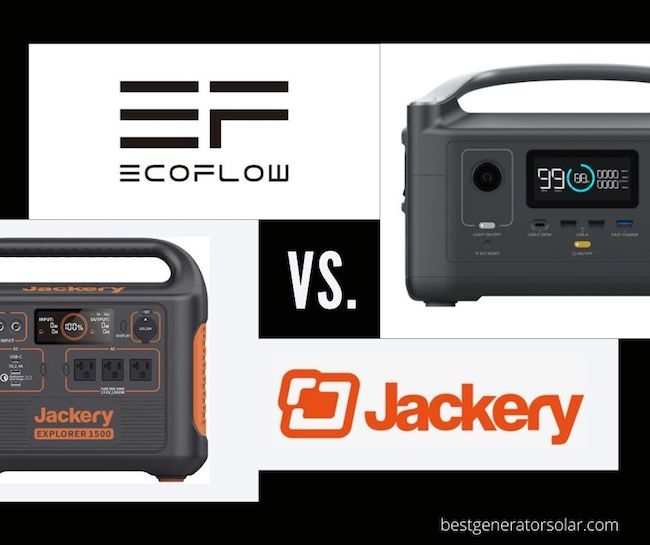
Both stations offer similar features, but Ecoflow is the best choice when it comes to more power, more port options, and faster recharging times.
With the ability to charge multiple devices at once (and quickly), it’s hard to beat. However, if you’re looking for the most value for your money, some Jackery models come at a cheaper price point than some EcoFlow models (example: the Jackery 240 over the EcoFlow River).
EcoFlow FAQ’s
Does the EcoFlow Delta support pass-through charging?
Yes, the Delta supports pass-through charging. However, it is not recommended to output more than 800W from the Delta while it is recharging.
What is Delta’s lifespan?
The lifespan of the Delta’s battery is dependent on how it is used and maintained. For example, the Delta’s capacity will drop to 80% after 800 cycles of use.
How should I store and maintain Delta?
To store and maintain Delta it is effective to discharge it until it reaches 30% and only charge it up to 85% every three months.
Using this charging will help prolong the lifespan of the battery and guarantee that the Delta is ready to recharge gear at all times.
There are also external factors that can take place. In cold weather (below freezing) can affect the battery capacity.
The optimal temperatures for normal use are -4 to 113 degrees Fahrenheit. For optimal use, the temperature is that of -4 to 77 degrees Fahrenheit.
For more information on the Delta, please check out the EcoFlow website.
Jackery FAQ’s
Can a Jackery 240 jump start a car?
No, a Jackery 240 cannot jump start a car. A car requires a significantly greater amount of power to start it up.
I have reviewed a portable car jump starter that costs $100 less than the Jackery 240 and you can check it out here (I’ve used this jump starter to jump my car several times): Fanttik T8 Apex Car Jump Starter Review (Testing & Comparison).
Does the Jackery 240 support pass through charging?
Yes, the Jackery 240 supports pass-through charging. This is stated within its user manual.
Can a Jackery 500 power a 12V fridge?
Yes, the Jackery 500 can power a 12V fridge for over 15 hours with a fridge that consumes 2.5 amps per hour. A large 12V fridge (six amps per hour) results in about seven hours of running time with the Jackery 500.
Can you replace a Jackery battery?
You cannot replace a Jackery portable power station battery. This applies to all of their power stations. The main ways to replace their batteries is to either purchase a new model or (if under warranty) request a new model.
For more information on Jackery power stations, please check out the Jackery website.

